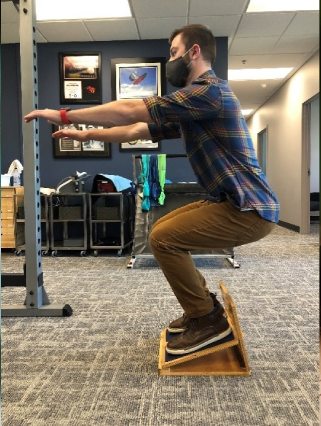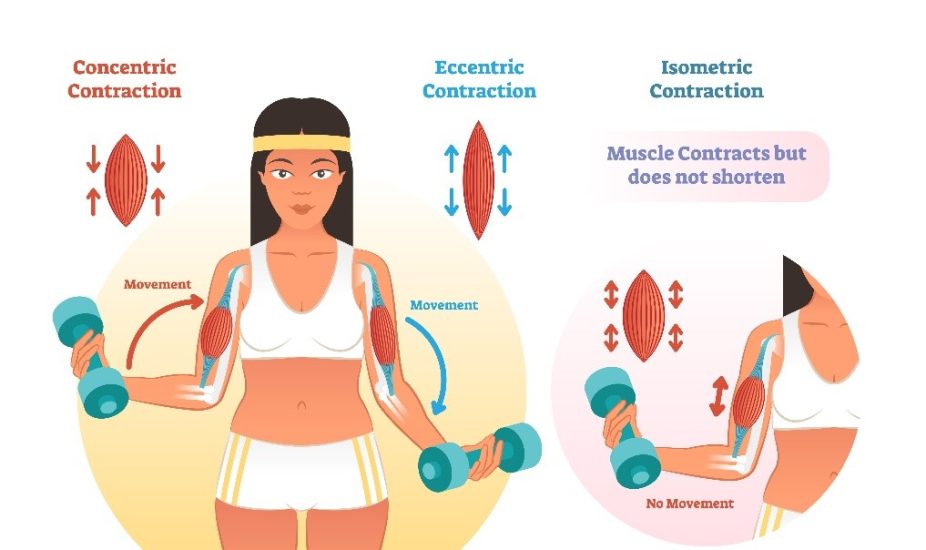There are multiple ways in which muscles produce tension, including isometric and isotonic contractions. Training in these specific methods produce similar outcomes, such as increased strength, but also provide unique benefits, such as improved muscle/tendon/joint health. Before we get too far, let us take a step back and look at each type of contraction.
Isometric contraction: A muscle contracts, but the joint it controls does not move. Think of holding a weight with your elbow bent to 90 degrees and does not move.
Isotonic contraction: A muscle contracts and the joint angle it controls increases and decreases while the muscle either shortens or lengthens. This can be further broken down into eccentric and concentric contractions…
- Eccentric contraction: The muscle is lengthening as it contracts. Think of holding a weight with your elbow bent to 90 degrees then lowering that weight to the point your elbow is straight. Your bicep has just performed an eccentric contraction.
- Concentric contraction: The muscle shortens as it contracts. Think of holding a weight with your elbow straight then bending it to 90 degrees. Your bicep has just performed a concentric contraction.
Muscles can produce the most amount of force, or develop the most amount of tension, eccentrically. This explains why someone can usually lower a heavy weight with control but struggles to push it up (for instance bench press). The more tension or force that is produced, the stronger the muscle becomes. Eccentric strengthening is an effective way to rehabilitate a weak muscle following surgery. For instance, many people cannot perform a straight leg raise following knee surgery because the quadriceps has basically shut down. We work instead on eccentrically lowering the leg with control, and before you know it, the person can begin lifting the leg up! Another use of eccentric contractions in physical therapy is during the treatment of tendinopathies. Slow, controlled heel drops or decline board squats are great for treating Achilles tendon and patellar tendon symptoms, respectively. The benefits of eccentric exercises are due to increased collagen synthesis and tendon remodeling found during force fluctuations. The drawback of heavy eccentric training is it is more likely to produce muscle soreness, both during and after exercises.

The second most effective way to develop tension in a muscle is isometrically. Isometrics are typically considered safer in the early phase of strengthening after surgery as it is very controlled, and one can self- monitor the effort they are applying. The drawback here is that the strengthening effect is specific to the joint angle you are holding (typically about 15 degrees each way). Therefore, it is best performed at a variety of angles. An example of isometric strengthening in physical therapy is shoulder internal or external rotation after shoulder surgery. Typically, patients can begin strengthening the shoulder after 10-12 weeks, and it is common to start with isometric contractions, as they are both comfortable and safe. This can be achieved by standing in a doorway with the elbow bent and gently pressing into the doorway with constant pressure while not adjusting the joint angle (do not attempt without speaking to your shoulder physical therapist first).

Concentric contractions develop the least amount of tension in the muscle. Most function including the upper extremities is performed using the muscle concentrically – ex. lifting objects above waist or shoulder height. This is the way most people train, and although it is very functional, you do not receive all the strength gains you may be anticipating.
In conclusion, there are benefits to each contraction. In physical therapy, we use all the above depending on our therapeutic outcome goals. In general fitness and exercise, you may use one contraction over another, again, depending on your fitness goals. All in all, each type of muscle contraction is important for overall function. The timing as to when you use a specific contraction can be particularly important, especially when recovering from injury or surgery.
If you would like to learn more, talk with your therapist at SportsCare Physical Therapy. If you are not yet a patient but feel you would benefit from some instruction and structured care, schedule an appointment online at one of our five convenient locations.

